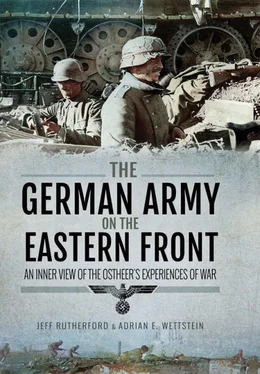Vegetables, spreads, sugar, spices and drinks should be obtained by the troops themselves when possible. The division provides these foodstuffs only on a temporary basis . Just because they are on the troops’ menu does not mean the troops must expect to receive them. […]
Evening food [rations] will be distributed from 7.7. only every two days. One evening meal must be acquired by the troops according to the rations set by Field Manual 86/1. Towards this goal, self-butchering can take place to the necessary extent.
We want to always keep in mind:
England wants to starve Germany.
Russia has the means that Germany needs.
As the division commander made clear, German occupation goals were seen as vital not just for the war in the east, but also for the larger struggle against the British Empire. While the army has been rightfully criticized by historians for ignoring the larger strategic issues of the war in favour of emphasizing operations, clearly some officers understood the importance of the Barbarossa campaign for a favourable outcome to the global struggle. This directive also contains the essence of the German struggle to effectively exploit Soviet agriculture during the war; while the order attempted to set limits on the troops’ foraging, it simultaneously encouraged them to take the initiative in finding their own nourishment.
As a result of an over-strained supply system, a focus on the army locating its own food in an area dependent on subsistence agriculture, the German belief that the fertile land of the east should provide for them and not the ‘inferior’ Slavs, and a delegation of authority to the lowest levels when it came to living off the land, such policies inevitably resulted in confrontations between German soldiers and Soviet civilians. Unable or unwilling to distinguish between ‘legitimate’ and ‘wild’ requisitioning, the troops frequently plundered Soviet peasants and their farms. The town commandant of Kholm reported in late summer that:
Despite the sharpest orders and despite supervision, the number of cases of German soldiers extorting cattle and foodstuffs from the population (sometimes through physical abuse) has increased. It is primarily a matter of villages lying outside of Kholm in which commandos appear and ‘organize.’ [6]Here, farmers often have their last piece of cattle taken away [and] in a few cases, money and valuables are stolen. Those parties affected then come to commandant’s office and complain.
So, for example, on 11.8.41, a unit passing through drove away an inhabitant’s last cow, punched him in the face, and allegedly took away a contribution of 3000 rubles.
A 75-year-old woman from Brzkoie (some 5km south of Kholm) came to the commandant and stated that on 17.8., a cavalry unit appeared, wanted to drive away her only cow, and when she begged on her knees for the cow to be left, a soldier hit her. The woman had marks from being hit on her face. Then the soldiers rode away and took with them a sheep and several chickens without payment or receipt.
A woman came to me with a voucher, which confirmed that an Obergefreiter (without his field post number) had taken a cow for 3 Reichsmark .
Since these are probably troops from outside of Kholm and from other divisions, the commandant asks for redress. [7]
Such behaviour played an important role in turning those sections of the population that initially welcomed the Germans into resisters. This was not an insignificant issue. In order to Sovietize the western fringes of the Soviet Union in the 1930s and early 1940s, Ukraine, Poland, and the Baltic States had been terrorized by Soviet power. Mass arrests, deportations, shootings and famine resulted in the imposition of Soviet control, but at the cost of any support from the local populations. Numerous German soldiers testified to being greeted by these various ethnic groups as liberators freeing them from the Bolshevik yoke, and it is clear that anti-Soviet attitudes could have been capitalized on by the Germans if any real attempts had been made. [8]Nazi racial policy and the army’s myopic focus on operations to the exclusion of all other considerations ensured, however, that in 1941 no such effort would be forthcoming and German practices in the occupied east transformed such potential support into outright resistance. One German soldier fighting in the Leningrad region noted that:
Last evening, Russian peasants dragged a dead cow here and made a loud clamour over their loss. With right! Some German soldier had killed the animal because he had a craving for liver. He took that with him and left the rest lying there. That arouses dissatisfaction with us and the careless black butcher [9]received an appropriate punishment. Now he had created another family of future partisans. [10]
Partisan activity remained a constant worry for the German army during the entirety of the campaign. This was partly based on ideological concerns: as the ‘Guidelines for the Conduct of the Troops in Russia’ made clear, the army expected irregular resistance as it believed that the ‘Judeo-Bolshevik’ leadership of the Soviet Union actively encouraged such underhanded methods of fighting. It was also based on the Germans’ understanding of the campaign they were going to fight. As panzer spearheads drove deep into the rear of the Red Army, their supply lines grew correspondingly long and difficult to secure. In hopes of smashing the partisan movement before it could become a major irritant, the army resorted to coercion and violence. The army’s traditional response to guerrilla warfare was based on military necessity and it manifested itself in what were known as collective measures: the arrest of an entire village, taking of hostages, burning down a community or the execution of suspected partisans. An order issued by Sixteenth Army in October 1941 elucidated this policy. [11]
a) Civilians convicted of sabotage or espionage are to be shot by an order of a responsible commander. When suspicion isn’t adequate for this, the commander can order a collective measure against the town or village in question. This is to be determined by the degree of destruction and the extent of suspicion. In case of repeated sabotage, for example on the means of communication, it is recommended to take hostages and to task their relatives with the guarding of the telephone lines.
b) Only when these measures by the troops unexpectedly fail to lead to success, can suspicious male civilians and conscripts be transported to the civilian camp in the prisoner of war transit camps, on order of the corps. […] Authorization to send convicted civilians to these camps can only be given in extreme emergencies. Such civilians are deported with accompanying guards on the railroad.
The army followed this traditional Prusso-German practice during the Second World War, though its actions on the Eastern front were clearly radicalized by Nazi ideology. [12]
Even though partisan activity failed to materialize into a true threat to German operations until 1942, scattered Red Army troops who managed to escape the large-scale encirclements proved to be an irritant to the Germans. [13]The following document provides an example of how a German collective measure was ordered and carried out by an artillery regiment during its advance:
The end of the 426th marching group on the road from Dorochova to Oserki took rifle fire on 21 July 1941 around 1900 hours from terrain overgrown with bushes and shrubs by the village of Puchova. A medic stepped out of the column and was shot at a distance of 5 meters by a civilian. The medic company then returned fire from its side. On my order, the bush and shrub covered terrain and the cornfields in the direction of the village were combed-through by members of the signal section under Leutnant Ullrich and by medics. I gave Leutnant Ullrich the order to proceed ruthlessly and to make use of summary justice.
Читать дальше






![John Stieber - Against the Odds - Survival on the Russian Front 1944-1945 [2nd Edition]](/books/405234/john-stieber-against-the-odds-survival-on-the-russian-front-1944-1945-2nd-edition-thumb.webp)





